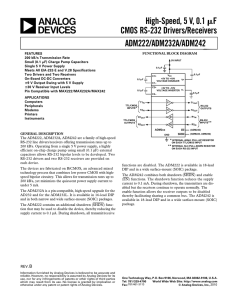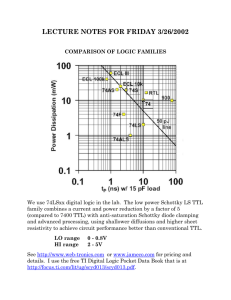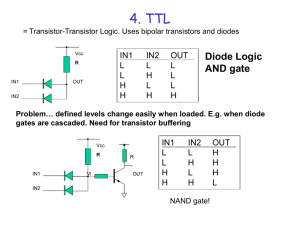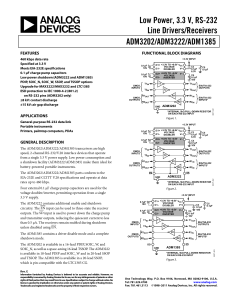0.1 μF, 5 V Powered CMOS RS-232 Drivers/Receivers ADM206/ADM207/ADM208/ADM211/ADM213
advertisement
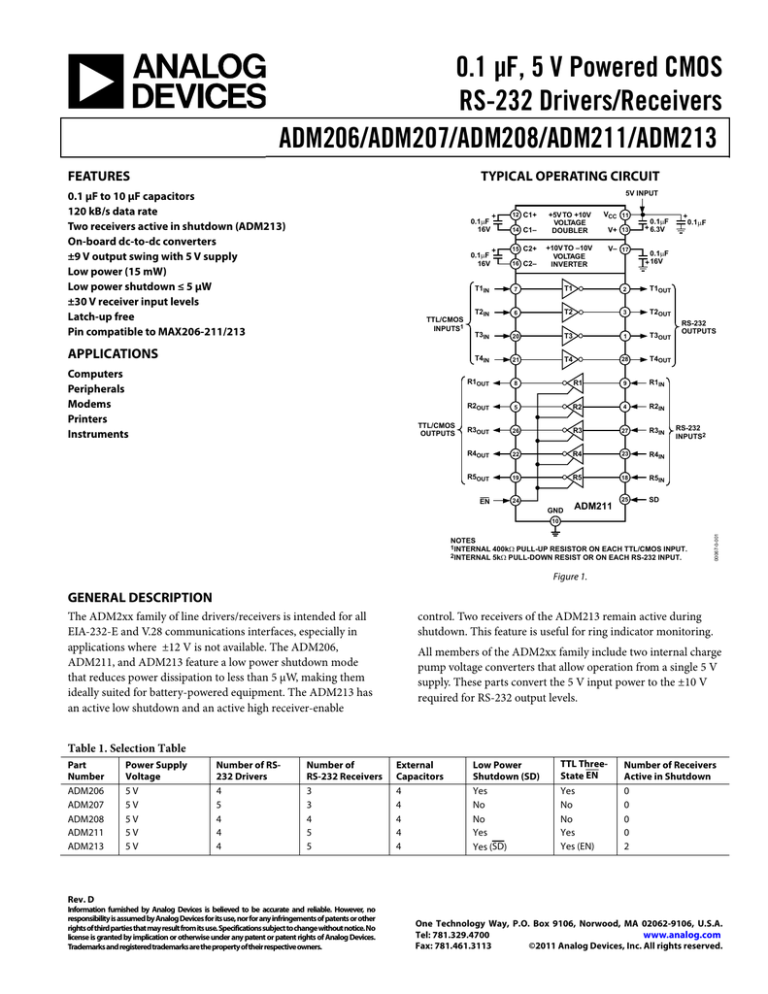
0.1 μF, 5 V Powered CMOS RS-232 Drivers/Receivers ADM206/ADM207/ADM208/ADM211/ADM213 FEATURES TYPICAL OPERATING CIRCUIT 5V INPUT 0.1 μF to 10 μF capacitors 120 kB/s data rate Two receivers active in shutdown (ADM213) On-board dc-to-dc converters ±9 V output swing with 5 V supply Low power (15 mW) Low power shutdown ≤ 5 μW ±30 V receiver input levels Latch-up free Pin compatible to MAX206-211/213 TTL/CMOS INPUTS1 APPLICATIONS Computers Peripherals Modems Printers Instruments TTL/CMOS OUTPUTS 0.1μF 16V + 0.1μF 16V + 12 C1+ 14 C1– 15 C2+ 16 C2– +5V TO +10V VOLTAGE DOUBLER VCC 11 +10V TO –10V VOLTAGE INVERTER V– 17 V+ 13 0.1μF + 6.3V 0.1μF + 16V T1IN 7 T1 2 T1OUT T2IN 6 T2 3 T2OUT T3IN 20 T3 1 T3OUT T4IN 21 T4 28 T4OUT R1OUT 8 R1 9 R1IN R2OUT 5 R2 4 R2IN R3OUT 26 R3 27 R3IN R4OUT 22 R4 23 R4IN R5OUT 19 R5 18 R5IN EN 24 25 SD GND ADM211 + 0.1μF RS-232 OUTPUTS RS-232 INPUTS2 NOTES 1INTERNAL 400kΩ PULL-UP RESISTOR ON EACH TTL/CMOS INPUT. 2INTERNAL 5kΩ PULL-DOWN RESIST OR ON EACH RS-232 INPUT. 00067-0-001 10 Figure 1. GENERAL DESCRIPTION The ADM2xx family of line drivers/receivers is intended for all EIA-232-E and V.28 communications interfaces, especially in applications where ±12 V is not available. The ADM206, ADM211, and ADM213 feature a low power shutdown mode that reduces power dissipation to less than 5 μW, making them ideally suited for battery-powered equipment. The ADM213 has an active low shutdown and an active high receiver-enable control. Two receivers of the ADM213 remain active during shutdown. This feature is useful for ring indicator monitoring. All members of the ADM2xx family include two internal charge pump voltage converters that allow operation from a single 5 V supply. These parts convert the 5 V input power to the ±10 V required for RS-232 output levels. Table 1. Selection Table Part Number ADM206 ADM207 ADM208 ADM211 ADM213 Power Supply Voltage 5V 5V 5V 5V 5V Number of RS232 Drivers 4 5 4 4 4 Number of RS-232 Receivers 3 3 4 5 5 External Capacitors 4 4 4 4 4 Low Power Shutdown (SD) Yes No No Yes Yes (SD) TTL ThreeState EN Yes No No Yes Yes (EN) Number of Receivers Active in Shutdown 0 0 0 0 2 Rev. D Information furnished by Analog Devices is believed to be accurate and reliable. However, no responsibility is assumed by Analog Devices for its use, nor for any infringements of patents or other rights of third parties that may result from its use. Specifications subject to change without notice. No license is granted by implication or otherwise under any patent or patent rights of Analog Devices. Trademarks and registered trademarks are the property of their respective owners. One Technology Way, P.O. Box 9106, Norwood, MA 02062-9106, U.S.A. Tel: 781.329.4700 www.analog.com Fax: 781.461.3113 ©2011 Analog Devices, Inc. All rights reserved. ADM206/ADM207/ADM208/ADM211/ADM213 TABLE OF CONTENTS Features .............................................................................................. 1 Pin Configurations and Function Descriptions ............................5 Applications ....................................................................................... 1 Typical Performance Characteristics ..............................................9 Typical Operating Circuit ................................................................ 1 General Information ...................................................................... 11 General Description ......................................................................... 1 Circuit Description .................................................................... 11 Revision History ............................................................................... 2 Application Hints ....................................................................... 12 Specifications..................................................................................... 3 Outline Dimensions ....................................................................... 13 Absolute Maximum Ratings............................................................ 4 Ordering Guide .......................................................................... 16 ESD Caution .................................................................................. 4 REVISION HISTORY 5/11—Data Sheet Changed from Rev. C to Rev. D Deleted ADM209 ................................................................ Universal Changes to Figure 5 .......................................................................... 5 Updated Outline Dimensions ....................................................... 13 Changes to Ordering Guide .......................................................... 15 1/05—Data Sheet Changed from Rev. B to Rev. C Changes to Specifications ................................................................ 3 Change to Receivers section .......................................................... 11 Change to Driving Long Cables section ...................................... 12 Updated Outline Dimensions ....................................................... 13 Changes to Ordering Guide .......................................................... 15 6/02—Data Sheet Changed from Rev. A to Rev. B Removed all references to ADM205 ................................ Universal 3/02—Data Sheet Changed from Rev. 0 to Rev. A Changes to numbers in Min/Typ/Max column of Specifications page ........................................................................... 2 Updated Figures ............................................................................ 8, 9 Revision 0: Initial Version Rev. D | Page 2 of 16 ADM206/ADM207/ADM208/ADM211/ADM213 SPECIFICATIONS VCC = 5 V ± 10% (ADM206, ADM207, ADM208, ADM211, ADM213); C1–C4 = 0.1 μF ceramic. All specifications TMIN to TMAX, unless otherwise noted. Table 2. Parameter Output Voltage Swing VCC Power Supply Current Shutdown Supply Current Input Logic Threshold Low, VINL Input Logic Threshold High, VINH Logic Pull-Up Current RS-232 Input Voltage Range 1 RS-232 Input Threshold Low RS-232 Input Threshold High RS-232 Input Hysteresis RS-232 Input Resistance TTL/CMOS Output Voltage Low, VOL TTL/CMOS Output Voltage High, VOH TTL/CMOS Output Leakage Current Output Enable Time (TEN) Output Disable Time (TDIS) Propagation Delay Transition Region Slew Rate Output Resistance RS-232 Output Short Circuit Current 1 Min ±5 Typ ±9 5 1 Max 13 10 0.8 2.0 10 –30 0.8 3 1.25 1.9 0.65 5 25 +30 2.4 7 0.4 3.5 0.05 115 165 0.5 8 ±10 ±12 ±60 5 300 Unit V mA μA V V μA V V V V kΩ V V μA ns ns μs V/μs Ω mA Test Conditions/Comments All transmitter outputs loaded with 3 kΩ to ground No load TIN, EN, SD, EN, SD TIN, EN, SD, EN, SD TIN = 0 V TA = 0°C to 85°C IOUT = 1.6 mA IOUT = –1.0 mA EN = VCC, EN = 0 V, 0 V ≤ ROUT ≤ VCC ADM206, ADM211 (Figure 22. CL = 150 pF) ADM206, ADM211 (Figure 22. RL = 1 kΩ) RS-232 to TTL RL = 3 kΩ, CL = 2500 pF; measured from +3 V to –3 V or –3 V to +3 V VCC = V+ = V– = 0 V, VOUT= ± 2 V Guaranteed by design. Rev. D | Page 3 of 16 ADM206/ADM207/ADM208/ADM211/ADM213 ABSOLUTE MAXIMUM RATINGS TA = 25°C, unless otherwise noted. Stresses above those listed under Absolute Maximum Ratings may cause permanent damage to the device. This is a stress rating only; functional operation of the device at these or any other conditions above those indicated in the operational section of this specification is not implied. Exposure to absolute maximum rating conditions for extended periods may affect device reliability. Table 3. Parameter VCC V+ V– Input Voltages TIN RIN Output Voltages TOUT ROUT Short-Circuit Duration TOUT Power Dissipation N-24 PDIP (Derate 13.5 mW/°C above 70°C) R-24 SOIC (Derate 12 mW/°C above 70°C) R-28 SOIC (Derate 12.5 mW/°C above 70°C) RS-24 SSOP (Derate 12 mW/°C above 70°C) RS-28 SSOP (Derate 10 mW/°C above 70°C) Thermal Impedance, θJA N-24 PDIP R-24 SOIC R-28 SOIC RS-24 SSOP RS-28 SSOP Operating Temperature Range Industrial (A Version) Storage Temperature Range Lead Temperature, Soldering Vapor Phase (60 s) Infrared (15 s) Min –0.3 V to +6 V (VCC – 0.3 V) to +14 V +0.3 V to –14 V –0.3 V to (VCC + 0.3 V) ±30 V (V+, +0.3 V) to (V–, –0.3 V) –0.3 V to (VCC + 0.3 V) ESD CAUTION Continuous 1000 mW 850 mW 900 mW 850 mW 900 mW 120°C/W 85°C/W 80°C/W 115°C/W 100°C/W –40°C to +85°C –65°C to +150°C 300°C 215°C 220° Rev. D | Page 4 of 16 ADM206/ADM207/ADM208/ADM211/ADM213 PIN CONFIGURATION4 AND FUNCTION DESCRIPTIONS T3OUT 1 24 T4OUT T3OUT 1 24 T4OUT T1OUT 2 23 R2IN T1OUT 2 23 R2IN T2OUT 3 22 R2OUT T2OUT 3 22 R2OUT R1IN 4 21 SD R1IN 4 21 T5IN R1OUT 5 20 EN R1OUT 5 T2IN 6 19 T4IN T2IN 6 T1IN 7 GND 8 17 R3OUT VCC 9 16 R3IN C1+ 10 15 V– C1+ 10 V+ 11 14 C2– C1– 12 13 C2+ Figure 2. ADM206 PDIP/SOIC/SSOP Pin Configuration 20 T5OUT T1IN TOP VIEW 19 T4IN 7 (Not to Scale) 18 T3IN GND 8 17 R3OUT VCC 9 16 R3IN 00067-0-002 TOP VIEW (Not to Scale) 18 T3 IN ADM207 15 V– V+ 11 14 C2– C1– 12 13 C2+ 00067-0-004 ADM206 Figure 4. ADM207 PDIP/SOIC/SSOP Pin Configuration 5V INPUT 5V INPUT 0.1μF 16V TTL/CMOS INPUTS1 C1+ 12 C1– 13 C2+ 14 C2– +5V TO +10V VOLTAGE DOUBLER +10V TO –10V VOLTAGE INVERTER T1IN 7 T1 T2IN 6 T2 VCC 9 V+ 11 V– 15 2 3 0.1μF + 6.3V 0.1μF 16V + 0.1μF 10 C1+ 12 C1– 13 C2+ 14 C2– +5V TO +10V VOLTAGE DOUBLER VCC 9 +10V TO –10V VOLTAGE INVERTER V– 15 V+ 11 0.1μF + 6.3V + 0.1μF 0.1μF + 16V 0.1μF + 16V T1OUT T2OUT T3IN 18 T3 1 T3OUT T4IN 19 T4 24 T4OUT R1OUT 5 R1 4 R1IN R2OUT 22 R2 23 R2IN R3OUT 17 R3 16 R3IN EN 20 ADM206 21 SD GND + TTL/CMOS INPUTS1 RS-232 OUTPUTS RS-232 INPUTS2 TTL/CMOS OUTPUTS NOTES 1INTERNAL 400kΩ PULL-UP RESISTOR ON EACH TTL/CMOS INPUT. 2INTERNAL 5kΩ PULL-DOWN RESISTOR ON EACH RS-232 INPUT. T1IN 7 T1 2 T1OUT T2IN 6 T2 3 T2OUT T3IN 18 T3 1 T3OUT T4IN 19 T4 24 T4OUT T5IN 21 T5 20 T5OUT R1OUT 5 R1 4 R1IN R2OUT 22 R2 23 R2IN R3OUT 17 R3 16 R3IN GND 8 RS-232 OUTPUTS RS-232 INPUTS2 ADM207 8 00067-0-003 TTL/CMOS OUTPUTS + 10 + NOTES 1INTERNAL 400k Ω PULL-UP RESISTOR ON EACH TTL/CMOS INPUT. 2INTERNAL 5kΩ PULL-DOWN RESISTOR ON EACH RS-232 INPUT. Figure 5. ADM207 Typical Operating Circuit Figure 3. ADM206 Typical Operating Circuit Rev. D | Page 5 of 16 00067-0-005 0.1μF 6.3V + 0.1μF 6.3V ADM206/ADM207/ADM208/ADM211/ADM213 28 27 R3IN T2OUT 3 26 R3OUT R2IN 4 25 SD T2OUT 1 24 T3OUT T1OUT 2 23 R3IN R2IN 3 22 R3OUT R2OUT 4 21 T4IN T2IN 6 T1IN 5 20 T4OUT T1IN 7 R1OUT 6 R1IN GND 8 17 R4OUT VCC 9 16 C1+ 10 V+ 11 C1– 12 R2OUT 5 24 EN ADM211 23 R4IN TOP VIEW 22 R4OUT R1OUT 8 (Not to Scale) 21 T4IN T3IN 20 19 R5OUT R4IN VCC 11 18 R5IN 15 V– C1+ 12 17 V– 14 C2– V+ 13 16 C2– 13 C2+ C1– 14 15 C2+ 00067-0-006 R1IN 9 GND 10 Figure 6. ADM208 PDIP/SOIC/SSOP Pin Configuration 00067-0-010 ADM208 TOP VIEW 19 T3IN 7 (Not to Scale) 18 T2IN T4OUT T3OUT 1 T1OUT 2 Figure 8. ADM211 SOIC/SSOP Pin Configuration 5V INPUT 5V INPUT 0.1μF 6.3V 0.1μF 16V TTL/CMOS INPUTS1 TTL/CMOS OUTPUTS + 10 C1+ 12 C1– + 13 C2+ 14 C2– +5V TO +10V VOLTAGE DOUBLER +10V TO –10V VOLTAGE INVERTER VCC 9 V+ 11 V– 15 0.1μF + 6.3V + 0.1μF 0.1μF + 16V 0.1μF 16V + 0.1μF 16V + 12 C1+ 14 C1– 15 C2+ 16 C2– +5V TO +10V VOLTAGE DOUBLER VCC 11 +10V TO –10V VOLTAGE INVERTER V– 17 V+ 13 0.1μF + 6.3V T1IN 7 T1 2 T1OUT T2IN 6 T2 3 T2OUT T3IN 20 T3 1 T3OUT T4IN 21 T4 28 T4OUT 5 T1 T2IN 18 T2 1 T2OUT T3IN 19 T3 24 T3OUT T4IN 21 T4 20 T4OUT R1OUT 8 R1 9 R1IN R2OUT 5 R2 4 R2IN R3OUT 26 R3 27 R3IN R4OUT 22 R4 23 R4IN R5OUT 19 R5 18 R5IN EN 24 25 SD T1OUT R1OUT 6 R1 7 R1IN R2OUT 4 R2 3 R2IN R3OUT 22 R3 23 R3IN R4OUT 17 R4 16 R4IN GND TTL/CMOS INPUTS1 RS-232 OUTPUTS TTL/CMOS OUTPUTS RS-232 INPUTS2 ADM208 8 GND ADM211 0.1μF 0.1μF + 16V T1IN 2 + RS-232 OUTPUTS RS-232 INPUTS2 Figure 9. ADM211 Typical Operating Circuit Figure 7. ADM208 Typical Operating Circuit Rev. D | Page 6 of 16 00067-0-011 NOTES 1INTERNAL 400kΩ PULL-UP RESISTOR ON EACH TTL/CMOS INPUT. 2INTERNAL 5kΩ PULL-DOWN RESISTOR ON EACH RS-232 INPUT. 00067-0-007 10 NOTES 1INTERNAL 400kΩ PULL-UP RESISTOR ON EACH TTL/CMOS INPUT. 2INTERNAL 5kΩ PULL-DOWN RESISTOR ON EACH RS-232 INPUT. ADM206/ADM207/ADM208/ADM211/ADM213 5V INPUT TTL/CMOS INPUTS1 28 T1OUT 2 27 R3IN T2OUT 3 26 R3OUT R2IN 4 25 SD R2OUT 5 24 EN 23 R4IN* T2IN 6 ADM213 + 0.1μF 16V + 12 C1+ 14 C1– 15 C2+ 16 C2– +5V TO +10V VOLTAGE DOUBLER VCC 11 +10V TO –10V VOLTAGE INVERTER V– 17 V+ 13 T1IN 7 TOP VIEW 22 R4OUT* R1OUT 8 (Not to Scale) 21 T4IN T3IN 20 GND 10 19 R5OUT* VCC 11 18 R5IN* 7 T1 2 T1OUT T2IN 6 T2 3 T2OUT T3IN 20 T3 1 T3OUT T4IN 21 T4 28 T4OUT R1OUT 8 R1 9 R1IN R2OUT 5 R2 4 R2IN R3OUT 26 R3 27 R3IN R4OUT3 22 R4 23 R4IN3 R5OUT3 19 R5 18 R5IN3 EN 24 25 SD C1+ 12 17 V– V+ 13 16 C2– C1– 14 15 C2+ * ACTIVE IN SHUTDOWN GND ADM213 RS-232 OUTPUTS RS-232 INPUTS2 10 00067-0-012 R1IN 9 + 0.1μF 0.1μF + 16V T1IN T4OUT TTL/CMOS OUTPUTS 0.1μF + 6.3V NOTES 1INTERNAL 400kΩ PULL-UP RESISTOR ON EACH TTL/CMOS INPUT. 2INTERNAL 5kΩ PULL-DOWN RESISTOR ON EACH RS-232 INPUT. 3ACTIVE IN SHUTDOWN. Figure 10. ADM213 SOIC/SSOP Pin Configuration Figure 11. ADM213 Typical Operating Circuit Rev. D | Page 7 of 16 00067-0-013 T3OUT 1 0.1μF 16V ADM206/ADM207/ADM208/ADM211/ADM213 Table 4. Pin Function Descriptions Mnemonic VCC V+ V– GND C1+ C1– C2+ C2– TIN TOUT RIN ROUT EN/EN SD/SD NC Function Power Supply Input. 5 V ± 10%. Internally Generated Positive Supply (10 V nominal). Internally Generated Negative Supply (–10 V Nominal). Ground Pin. Must be connected to 0 V. External Capacitor (+ terminal) is connected to this pin. External Capacitor (– terminal) is connected to this pin. External Capacitor (+ terminal) is connected to this pin. External Capacitor (– terminal) is connected to this pin. Transmitter (Driver) Inputs. These inputs accept TTL/CMOS levels. An internal 400 kΩ pull-up resistor to VCC is connected to each input. Transmitter (Driver) Outputs. These are RS-232 levels (typically ± 10 V). Receiver Inputs. These inputs accept RS-232 signal levels. An internal 5 kΩ pull-down resistor to GND is connected to each input. Receiver Outputs. These are TTL/CMOS levels. Enable Input. Active low on ADM206 and ADM211. Active high on ADM213. This input is used to enable/disable the receiver outputs. With EN = low (EN = high ADM213), the receiver outputs are enabled. With EN = high (EN = low ADM213), the outputs are placed in a high impedance state. This is useful for connecting to microprocessor systems. Shutdown Input. Active high on ADM206 and ADM211. Active low on ADM213. With SD = high on the ADM206 and ADM211, the charge pump is disabled, the receiver outputs are placed in a high impedance state, and the driver outputs are turned off. With SD = low on the ADM213, the charge pump is disabled, the driver outputs are turned off, and all receivers, except R4 and R5, are placed in a high impedance state. In shutdown, the power consumption reduces to 5 μW. No Connect. No connections are required to this pin. Table 5. ADM206 and ADM211 Truth Table SD 0 0 1 EN 0 1 0 Status Normal Operation Normal Operation Shutdown Transmitters T1–T5 Enabled Enabled Disabled Receivers R1–R5 Enabled Disabled Disabled Transmitters T1–T4 Disabled Disabled Enabled Enabled Receivers R1–R3 Disabled Disabled Disabled Enabled Table 6. ADM213 Truth Table SD 0 0 1 1 EN 0 1 0 1 Status Shutdown Shutdown Normal Operation Normal Operation Rev. D | Page 8 of 16 Receivers R4, R5 Disabled Enabled Disabled Enabled ADM206/ADM207/ADM208/ADM211/ADM213 TYPICAL PERFORMANCE CHARACTERISTICS 15 15 10 10 V+ Tx O/P HIGH 5 Tx O/P (V) 0 –5 0 –5 V– –10 Tx O/P LOW –15 0 5 10 LOAD CURRENT (mA) 20 15 00067-0-014 –10 –15 Figure 12. Charge Pump V+, V– vs. Load Current 0 8 10 Figure 15. Transmitter Output Voltage vs. Load Current 350 50 45 300 V– IMP 40 250 35 IMPEDANCE (Ω) SLEW RATE (V/μs) 4 6 LOAD CURRENT (mA) 2 00067-0-017 V+/V– (V) 5 30 25 NEGATIVE SLEW 20 15 200 150 V+ IMP 100 10 0 500 1000 1500 2000 LOAD CAPACITANCE (pF) 2500 3000 00067-0-015 0 0 4.5 4.7 4.9 5.1 5.3 5.5 VCC (V) Figure 13. Transmitter Slew Rate vs. Load Capacitance Figure 16. Charge Pump Impedance vs. VCC 9 7 Tx O/P HIGH LOADED 5 T 1 1 0 –1 SD V+ T 2 –3 3 T –5 –9 V– Tx O/P LOW LOADED 4.0 4.5 5.0 VCC (V) 5.5 6.0 3.1V CH1 5.00V CH2 5.00V M50.0μs CH1 CH3 5.00V BW V+, V– EXITING SHUTDOWN (SD) Figure 14. Transmitter Output Voltage vs. VCC 00067-0-019 –7 00067-0-016 Tx O/P (V) 3 Figure 17. Charge Pump, V+, V– Exiting Shutdown Rev. D | Page 9 of 16 00067-0-018 50 POSITIVE SLEW 5 ADM206/ADM207/ADM208/ADM211/ADM213 Tx INPUT T 1 T 1 T Tx INPUT T 2 2 Tx OUTPUT 800mV CH1 5.00V Figure 18. Transmitter Output Loaded Slew Rate CH2 5.00V M1.00μs CH1 800mV Figure 19. Transmitter Output Unloaded Slew Rate Rev. D | Page 10 of 16 00067-0-021 CH2 5.00V M1.00μs CH1 00067-0-020 CH1 5.00V Tx OUTPUT ADM206/ADM207/ADM208/ADM211/ADM213 GENERAL INFORMATION The ADM206, ADM211, and ADM213 are particularly useful in battery-powered systems because they feature a low power shutdown mode that reduces power dissipation to less than 5 μW. To facilitate sharing a common line or for connection to a microprocessor data bus, the ADM206, the ADM211, and the ADM213 feature an enable (EN) function. When the receivers are disabled, their outputs are placed in a high impedance state. CIRCUIT DESCRIPTION The internal circuitry in the ADM2xx consists of three main sections: (a) a charge pump voltage converter; (b) RS-232-toTTL/CMOS receivers; and (c) TTL/CMOS-to-RS-232 transmitters. Charge Pump DC-to-DC Voltage Converter The charge pump voltage converter consists of an oscillator and a switching matrix. The converter generates a ±10 V supply from the 5 V input. This is done in two stages using a switched capacitor technique, as illustrated in Figure 20 and Figure 21. First, the 5 V input supply is doubled to 10 V using capacitor C1 as the charge storage element. The 10 V level is then inverted to generate –10 V using C2 as the storage element. S3 C1 S2 + C3 + S4 GND INTERNAL OSCILLATOR Figure 20. Charge Pump Voltage Doubler V+ = 2VCC VCC 00067-0-022 S1 VCC S3 S1 V+ FROM VOLTAGE DOUBLER GND C2 S2 + C4 + S4 GND V– = –(V+) INTERNAL OSCILLATOR 00067-0-023 The ADM2xx family of RS-232 drivers/ receivers is designed to solve interface problems by meeting the EIA-232-E specifications while using a single digital 5 V supply. The EIA232-E standard requires transmitters that will deliver ±5 V minimum on the transmission channel and receivers that can accept signal levels down to ±3 V. The ADM2xx meet these requirements by integrating step-up voltage converters and level shifting transmitters and receivers onto the same chip. CMOS technology is used to keep the power dissipation to an absolute minimum. A comprehensive range of transmitter/ receiver combinations is available to cover most communication needs. The ADM2xx are modifications, enhancements, and improvements to the AD2xx family and derivatives thereof. They are essentially plug-in compatible and do not have materially different applications. Figure 21. Charge Pump Voltage Inverter Capacitors C3 and C4 are used to reduce the output ripple. Their values are not critical and can be reduced if higher levels of ripple are acceptable. The charge pump capacitors C1 and C2 may also be reduced at the expense of higher output impedance on the V+ and V– supplies. The V+ and V– supplies may also be used to power external circuitry if the current requirements are small. Transmitters (Drivers) The drivers convert TTL/CMOS input levels into EIA-232-E output levels. With VCC = +5 V and driving a typical EIA-232-E load, the output voltage swing is ±9 V. Even under worst-case conditions, the drivers are guaranteed to meet the ±5 V EIA232-E minimum requirement. The input threshold levels are both TTL- and CMOS-compatible with the switching threshold set at VCC/4. With a nominal VCC = 5 V, the switching threshold is 1.25 V typical. Unused inputs may be left unconnected, because an internal 400 kΩ pull-up resistor pulls them high, forcing the outputs into a low state. As required by the EIA-232-E standard, the slew rate is limited to less than 30 V/μs, without the need for an external slew limiting capacitor, and the output impedance in the power-off state is greater than 300 Ω. Receivers The receivers are inverting level shifters that accept EIA-232-E input levels (±5 V to ±15 V) and translate them into 5 V TTL/ CMOS levels. The inputs have internal 5 kΩ pull-down resistors to ground and are also protected against overvoltages of up to ±30 V. The guaranteed switching thresholds are 0.8 V minimum and 2.4 V maximum, well within the ±3 V EIA-232-E requirement. The low level threshold is deliberately positive, since it ensures that an unconnected input will be interpreted as a low level. The receivers have Schmitt-trigger inputs with a hysteresis level of 0.65 V. This ensures error-free reception for both noisy inputs and inputs with slow transition times. Rev. D | Page 11 of 16 ADM206/ADM207/ADM208/ADM211/ADM213 Shutdown (SD) APPLICATION HINTS The ADM2xx feature a control input that may be used to disable the part and reduce the power consump-ion to less than 5 ΩW. This is very useful in battery-operated systems. During shutdown, the charge pump is turned off, the transmitters are disabled, and all receivers except R4 and R5 on the ADM213 are put into a high impedance disabled state. Receivers R4 and R5 on the ADM213 remain enabled during shutdown. This feature allows monitoring external activity while the device is in a low power shutdown mode. The shutdown control input is active high on all parts except the ADM213, where it is active low. See Table 5 and Table 6. Driving Long Cables Enable Input The ADM211 and ADM213 feature an enable input used to enable or disable the receiver outputs. The enable input is active low on the ADM211 and active high on the ADM213. See Table 5 and Table 6. When the receivers are disabled, their outputs are placed in a high impedance state. This function allows the outputs to be connected directly to a microprocessor data bus. It can also be used to allow receivers from different devices to share a common data line. The timing diagram for the enable function is shown in Figure 22. In accordance with the EIA-232-E standard, long cables are permissible provided the total load capacitance does not exceed 2500 pF. For longer cables that do exceed this, it is possible to trade off baud rate for cable length. Large load capacitances cause a reduction in slew rate, and therefore the maximum transmission baud rate is decreased. The ADM2xx are designed to minimize the slew rate reduction that occurs as load capacitance increases. For the receivers, it is important that a high level of noise immunity be inbuilt so that slow rise and fall times do not cause multiple output transitions as the signal passes slowly through the transition region. The ADM2xx have 0.65 V of hysteresis to guard against this. This ensures that even in noisy environments error-free reception can be achieved. High Baud Rate Operation The ADM2xx feature high slew rates, permitting data transmission at rates well in excess of the EIA-232-E specification. The drivers maintain ±5 V signal levels at data rates up to 120 kB/s under worst-case loading conditions. 3V EN* 0V TEN 3.5V VOH – 0.1V 0.8V VOL + 0.1V ROUT * POLARITY OF EN IS REVERSED FOR ADM213. 00067-0-024 TDIS Figure 22. Enable Timing Rev. D | Page 12 of 16 ADM206/ADM207/ADM208/ADM211/ADM213 OUTLINE DIMENSIONS 1.185 (30.01) 1.165 (29.59) 1.145 (29.08) 24 13 1 12 0.180 (4.57) MAX 0.150 (3.81) 0.130 (3.30) 0.110 (2.79) 0.295 (7.49) 0.285 (7.24) 0.275 (6.99) 0.325 (8.26) 0.310 (7.87) 0.300 (7.62) 0.015 (0.38) MIN 0.022 (0.56) 0.018 (0.46) 0.014 (0.36) 0.100 (2.54) BSC 0.150 (3.81) 0.135 (3.43) 0.120 (3.05) 0.060 (1.52) SEATING 0.050 (1.27) PLANE 0.045 (1.14) 0.015 (0.38) 0.010 (0.25) 0.008 (0.20) COMPLIANT TO JEDEC STANDARDS MO-095AG CONTROLLING DIMENSIONS ARE IN INCHES; MILLIMETER DIMENSIONS (IN PARENTHESES) ARE ROUNDED-OFF INCH EQUIVALENTS FOR REFERENCE ONLY AND ARE NOT APPROPRIATE FOR USE IN DESIGN Figure 23. 24-Lead Plastic Dual In-Line Package [PDIP] Narrow Body (N-24-1) Dimensions shown in inches and (millimeters) 15.60 (0.6142) 15.20 (0.5984) 24 13 7.60 (0.2992) 7.40 (0.2913) 1 12 10.65 (0.4193) 10.00 (0.3937) 2.65 (0.1043) 2.35 (0.0925) 0.75 (0.0295) × 45° 0.25 (0.0098) 0.30 (0.0118) 0.10 (0.0039) COPLANARITY 1.27 (0.0500) BSC 0.10 0.51 (0.020) 0.31 (0.012) 8° SEATING 0.33 (0.0130) 0° PLANE 0.20 (0.0079) 1.27 (0.0500) 0.40 (0.0157) COMPLIANT TO JEDEC STANDARDS MS-013AD CONTROLLING DIMENSIONS ARE IN MILLIMETERS; INCH DIMENSIONS (IN PARENTHESES) ARE ROUNDED-OFF MILLIMETER EQUIVALENTS FOR REFERENCE ONLY AND ARE NOT APPROPRIATE FOR USE IN DESIGN Figure 24. 24-Lead Standard Small Outline Package [SOIC_W] Wide Body (RW-24) Dimensions shown in millimeters and (inches) Rev. D | Page 13 of 16 ADM206/ADM207/ADM208/ADM211/ADM213 8.50 8.20 7.90 24 13 8.20 7.80 7.40 5.60 5.30 5.00 12 1 PIN 1 2.00 MAX 0.65 BSC 0.05 MIN 1.85 1.75 1.65 COPLANARITY 0.10 0.38 0.22 SEATING PLANE 0.95 0.75 0.55 8° 4° 0° 0.25 0.09 COMPLIANT TO JEDEC STANDARDS MO-150AG Figure 25. 24-Lead Shrink Small Outline Package [SSOP] (RS-24) Dimensions shown in millimeters 18.10 (0.7126) 17.70 (0.6969) 28 15 7.60 (0.2992) 7.40 (0.2913) 1 14 2.65 (0.1043) 2.35 (0.0925) 10.65 (0.4193) 10.00 (0.3937) 0.75 (0.0295) × 45° 0.25 (0.0098) 0.30 (0.0118) 0.10 (0.0039) COPLANARITY 0.10 8° 1.27 (0.0500) 0.51 (0.0201) SEATING 0.33 (0.0130) 0° BSC PLANE 0.33 (0.0130) 0.20 (0.0079) 1.27 (0.0500) 0.40 (0.0157) COMPLIANT TO JEDEC STANDARDS MS-013AE CONTROLLING DIMENSIONS ARE IN MILLIMETERS; INCH DIMENSIONS (IN PARENTHESES) ARE ROUNDED-OFF MILLIMETER EQUIVALENTS FOR REFERENCE ONLY AND ARE NOT APPROPRIATE FOR USE IN DESIGN Figure 26. 28-Lead Standard Small Outline Package [SOIC_W] Wide Body (RW-28) Dimensions shown in millimeters and (inches) Rev. D | Page 14 of 16 ADM206/ADM207/ADM208/ADM211/ADM213 10.50 10.20 9.90 28 15 5.60 5.30 5.00 8.20 7.80 7.40 14 1 PIN 1 1.85 1.75 1.65 2.00 MAX COPLANARITY 0.10 0.25 0.09 0.05 MIN 0.65 BSC 0.38 0.22 SEATING PLANE 8° 4° 0° COMPLIANT TO JEDEC STANDARDS MO-150AH Figure 27. 28-Lead Shrink Small Outline Package [SSOP] (RS-28) Dimensions shown in millimeters Rev. D | Page 15 of 16 0.95 0.75 0.55 ADM206/ADM207/ADM208/ADM211/ADM213 ORDERING GUIDE Model 1 ADM206AN ADM206ANZ ADM206AR ADM206AR-REEL ADM206ARZ ADM206ARZ-REEL ADM206ARS ADM206ARSZ ADM206ARSZ-REEL ADM207AN ADM207ANZ ADM207AR ADM207ARZ ADM207ARZ-REEL ADM207ARS ADM207ARSZ ADM207ARSZ-REEL ADM208AN ADM208ANZ ADM208AR ADM208AR-REEL ADM208ARZ ADM208ARZ-REEL ADM208ARSZ ADM208ARSZ-REEL ADM211AR ADM211AR-REEL ADM211ARZ ADM211ARZ-REEL ADM211ARS ADM211ARS-REEL ADM211ARSZ ADM211ARSZ-REEL ADM213AR ADM213ARZ ADM213ARZ-REEL ADM213ARS ADM213ARS-REEL ADM213ARSZ ADM213ARSZ-REEL 1 Temperature Range –40°C to +85°C –40°C to +85°C –40°C to +85°C –40°C to +85°C –40°C to +85°C –40°C to +85°C –40°C to +85°C –40°C to +85°C –40°C to +85°C –40°C to +85°C –40°C to +85°C –40°C to +85°C –40°C to +85°C –40°C to +85°C –40°C to +85°C –40°C to +85°C –40°C to +85°C –40°C to +85°C –40°C to +85°C –40°C to +85°C –40°C to +85°C –40°C to +85°C –40°C to +85°C –40°C to +85°C –40°C to +85°C –40°C to +85°C –40°C to +85°C –40°C to +85°C –40°C to +85°C –40°C to +85°C –40°C to +85°C –40°C to +85°C –40°C to +85°C –40°C to +85°C –40°C to +85°C –40°C to +85°C –40°C to +85°C –40°C to +85°C –40°C to +85°C –40°C to +85°C Package Description 24-lead PDIP 24-lead PDIP 24-lead SOIC_W 24-lead SOIC_W 24-lead SOIC_W 24-lead SOIC_W 24-lead SSOP 24-lead SSOP 24-lead SSOP 24-lead PDIP 24-lead PDIP 24-lead SOIC_W 24-lead SOIC_W 24-lead SOIC_W 24-lead SSOP 24-lead SSOP 24-lead SSOP 24-lead PDIP 24-lead PDIP 24-lead SOIC_W 24-lead SOIC_W 24-lead SOIC_W 24-lead SOIC_W 24-lead SSOP 24-lead SSOP 28-lead SOIC_W 28-lead SOIC_W 28-lead SOIC_W 28-lead SOIC_W 28-lead SSOP 28-lead SSOP 28-lead SSOP 28-lead SSOP 28-lead SOIC_W 28-lead SOIC_W 28-lead SOIC_W 28-lead SSOP 28-lead SSOP 28-lead SSOP 28-lead SSOP Z = RoHS Compliant Part. ©2011 Analog Devices, Inc. All rights reserved. Trademarks and registered trademarks are the property of their respective owners. D00067-0-5/11(D) Rev. D | Page 16 of 16 Package Option N-24-1 N-24-1 RW-24 RW-24 RW-24 RW-24 RS-24 RS-24 RS-24 N-24-1 N-24-1 RW-24 RW-24 RW-24 RS-24 RS-24 RS-24 N-24-1 N-24-1 RW-24 RW-24 RW-24 RW-24 RS-24 RS-24 RW-28 RW-28 RW-28 RW-28 RS-28 RS-28 RS-28 RS-28 RW-28 RW-28 RW-28 RS-28 RS-28 RS-28 RS-28
